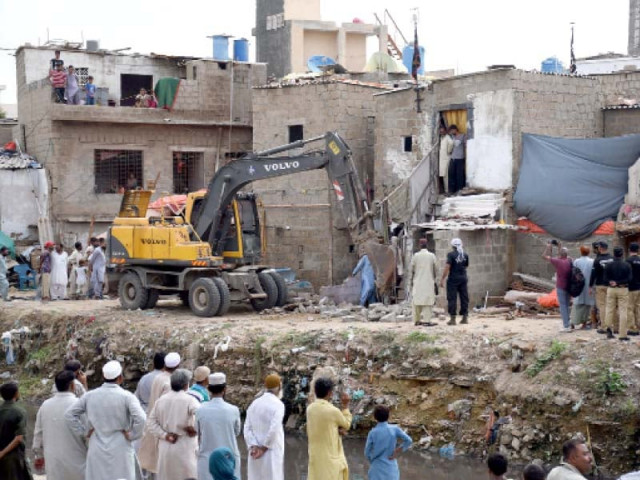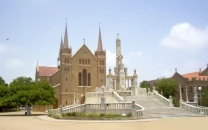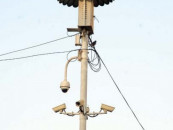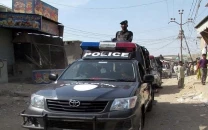Anti-encroachment drive: Authorities go easy on first day
Raze handful of shanties, shades and fences in Moosa Colony, Gulberg, New Karachi

The authorities were seen adopting a rather held-back approach on the first day of an anti-encroachment drive launched on Wednesday, primarily aimed at razing illegal structures on and near nullahs in Karachi, starting with Gujjar nullah.
In an imminent move that still came as a shock to many, the Sindh government announced the demolition campaign on Tuesday, giving an ultimatum of mere hours to the residents of illegal dwellings located within a radius of 100 feet of Gujjar nullah and ordering them to vacate their houses by 7am on Wednesday.
The announcement had created panic among the residents, who demanded alternative accommodation.
However, as the deadline ended and in the wake of uproar on the ground and on social media, the authorities went easy on them, demolishing only a few fences, shanties and shades.
The operation commenced at three spots near Gujjar nullah, namely Moosa Colony and Gulberg and in areas near a strip of nullah in New Karachi, by Karachi Metropolitan Corporation (KMC) teams under the supervision of North Nazimabad assistant commissioner (AC) Arsalan Saleem and KMC anti-encroachment senior director Bashir Siddiqui.
As KMC teams reached Gulberg, residents poured into the streets in anticipation and fear. However, only a few structures were razed before the operation was suspended, with the heavy machinery brought there remaining unused.
However, a citizen was arrested for resisting the operation.
Similarly, the scope of the campaign in Moosa Colony and New Karachi was also kept limited, with some shops and a few other structures demolished, though police personnel remained on hand to deal with any resistance.
The grand plan
Talking to The Express Tribune, AC Saleem elaborated that encroachments located within 105 feet of Gujjar nullah on both sides were to be razed, so that the drain was restored to its original condition. Explaining further, he said illegal structures, starting from a bus stop in New Karachi to Café Pyala and further extending to Dr Ziauddin Hospital and Lyari, would be removed along the nullah's length.
According to the AC, the authorities had launched multiple drives in Gujjar nullah's vicinity in the past, but illegal construction continued unabated.
"This is the reason why the nullah overflowed during rainfall, leaving many residential areas flooded," he added.
Along similar lines, Siddiqui stressed the need for removing encroachments to "save the city from drowning in rainwater."
The AC said that they were keeping the operation lenient during the initial phase.
In this regard, Siddiqui said they planned to vacate the area near the nullah at Teen Hatti to create space for machinery to remove encroachments and garbage, adding that the residents of illegal houses would be asked to vacate their homes during the second phase.
Siddiqui laid emphasis on the need for the institutions to work together on the matter and said, "All encroachments will be razed, whether they are located in areas under the KMC's jurisdiction or not."
On homelessness
Speaking about the threat of homelessness as a result of the drive, Siddiqui denied that it would leave anyone without a roof over their heads.
"Nobody will be left homeless due to the operation as only shanties and cattle farms are being razed, which were re-established following a demolition drive two years ago," he commented. "[Most] residents don't have lease documentation, issued by the KMC, Karachi Development Authority, Sindh Revenue Board, Sindh Katchi Abadi Authority and other relevant authorities, and this issue is 40 years to 50 years old."
According to Siddiqui, all leases for illegal structures had been cancelled in the light of a Supreme Court order.
Asked about the provision of alternative accommodation to affected persons, he said the Sindh government would decide whether to provide alternative housing to those who could produce documents for their existing properties.
Resistance
On the other hand, residents fearing displacement have called for action against the authorities that let them establish encroachments in the first place.
Talking to The Express Tribune, though they admitted that the houses were built illegally, the residents pointed out that the authorities knew this before permitting their construction.
Claiming their right on their properties, they said they had lease documents and had registered for gas, electricity and gas connections for their houses.
They accused the relevant authorities, including police and the KMC, of collecting bribes from them in return for allowing construction and providing utility connections.
The residents demanded the government provide them alternative accommodation, instead of depriving them of the homes where they said they had invested hundreds of thousands of rupees, built on the basis of legal documentation.
Published in The Express Tribune, September 3rd, 2020.



















COMMENTS
Comments are moderated and generally will be posted if they are on-topic and not abusive.
For more information, please see our Comments FAQ